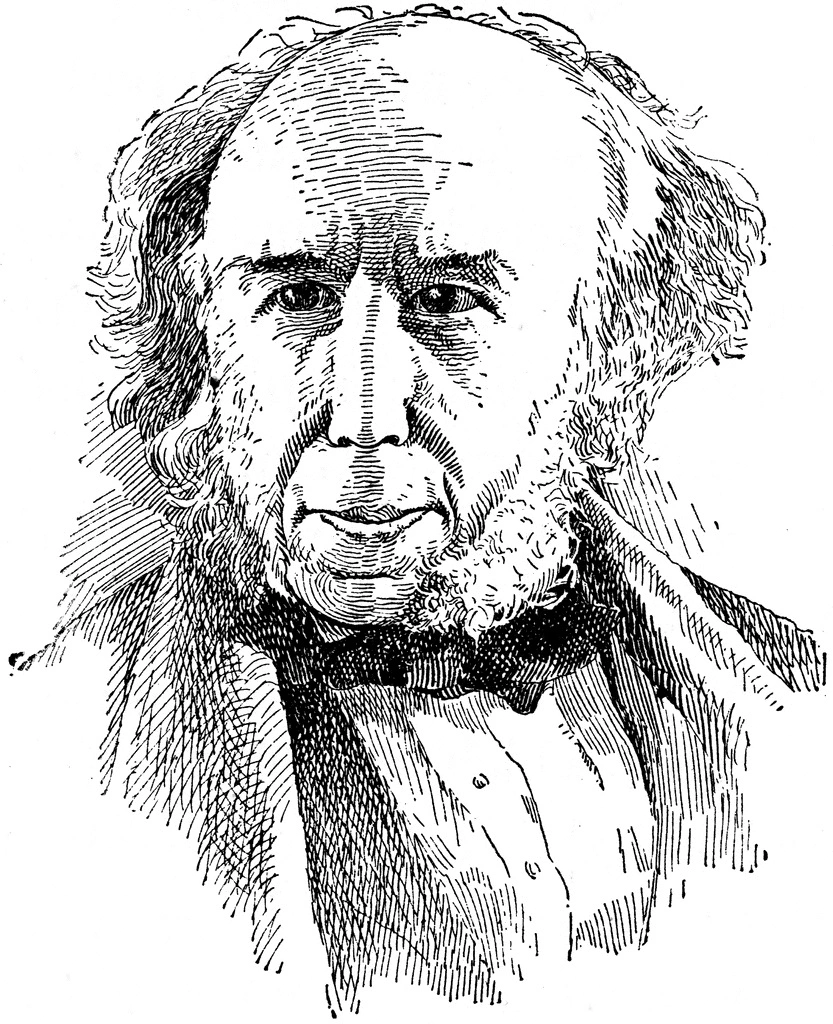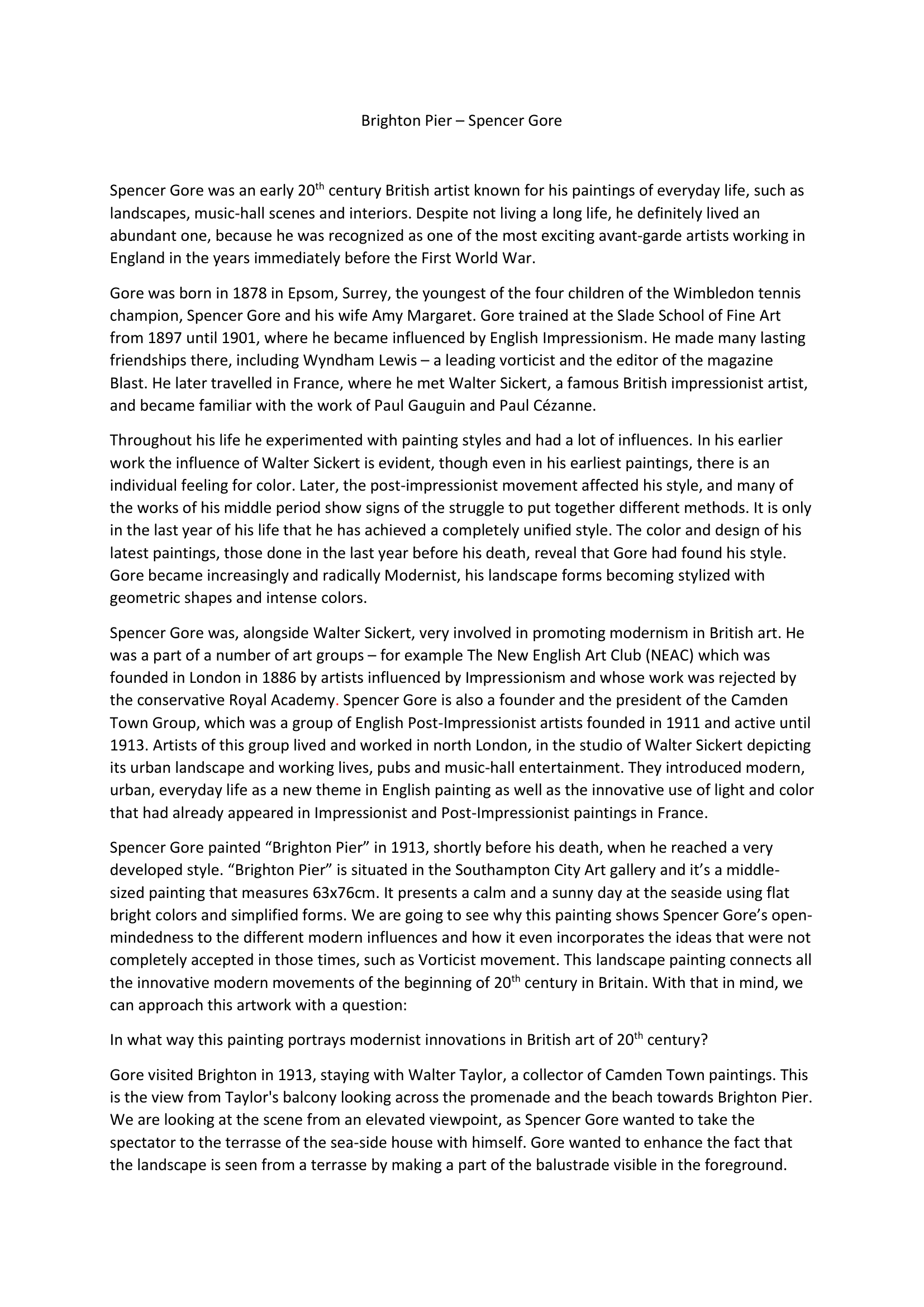Spencer Gore - Brighton Pier
Publié le 10/03/2022

Extrait du document

«
Brighton Pier – Spencer Gore
Spencer Gore was an early 20th century British artist known for his paintings of everyday life, such as
landscapes, music-hall scenes and interiors.
Despite not living a long life, he definitely lived an
abundant one, because he was recognized as one of the most exciting avant-garde artists working in
England in the years immediately before the First World War.
Gore was born in 1878 in Epsom, Surrey, the youngest of the four children of the Wimbledon tennis
champion, Spencer Gore and his wife Amy Margaret.
Gore trained at the Slade School of Fine Art
from 1897 until 1901, where he became influenced by English Impressionism.
He made many lasting
friendships there, including Wyndham Lewis – a leading vorticist and the editor of the magazine
Blast.
He later travelled in France, where he met Walter Sickert, a famous British impressionist artist,
and became familiar with the work of Paul Gauguin and Paul Cézanne.
Throughout his life he experimented with painting styles and had a lot of influences.
In his earlier
work the influence of Walter Sickert is evident, though even in his earliest paintings, there is an
individual feeling for color.
Later, the post-impressionist movement affected his style, and many of
the works of his middle period show signs of the struggle to put together different methods.
It is only
in the last year of his life that he has achieved a completely unified style.
The color and design of his
latest paintings, those done in the last year before his death, reveal that Gore had found his style.
Gore became increasingly and radically Modernist, his landscape forms becoming stylized with
geometric shapes and intense colors.
Spencer Gore was, alongside Walter Sickert, very involved in promoting modernism in British art.
He
was a part of a number of art groups – for example The New English Art Club (NEAC) which was
founded in London in 1886 by artists influenced by Impressionism and whose work was rejected by
the conservative Royal Academy.
Spencer Gore is also a founder and the president of the Camden
Town Group, which was a group of English Post-Impressionist artists founded in 1911 and active until
1913.
Artists of this group lived and worked in north London, in the studio of Walter Sickert depicting
its urban landscape and working lives, pubs and music-hall entertainment.
They introduced modern,
urban, everyday life as a new theme in English painting as well as the innovative use of light and color
that had already appeared in Impressionist and Post-Impressionist paintings in France.
Spencer Gore painted “Brighton Pier” in 1913, shortly before his death, when he reached a very
developed style.
“Brighton Pier” is situated in the Southampton City Art gallery and it’s a middlesized painting that measures 63x76cm.
It presents a calm and a sunny day at the seaside using flat
bright colors and simplified forms.
We are going to see why this painting shows Spencer Gore’s openmindedness to the different modern influences and how it even incorporates the ideas that were not
completely accepted in those times, such as Vorticist movement.
This landscape painting connects all
the innovative modern movements of the beginning of 20th century in Britain.
With that in mind, we
can approach this artwork with a question:
In what way this painting portrays modernist innovations in British art of 20th century?
Gore visited Brighton in 1913, staying with Walter Taylor, a collector of Camden Town paintings.
This
is the view from Taylor's balcony looking across the promenade and the beach towards Brighton Pier.
We are looking at the scene from an elevated viewpoint, as Spencer Gore wanted to take the
spectator to the terrasse of the sea-side house with himself.
Gore wanted to enhance the fact that
the landscape is seen from a terrasse by making a part of the balustrade visible in the foreground..
»
↓↓↓ APERÇU DU DOCUMENT ↓↓↓
Liens utiles
- « Le grand dessein de l'éducation, c'est l'action, pas la connaissance » Spencer
- PRINCIPES DE SOCIOLOGIE, Herbert Spencer (résumé)
- PRINCIPES DE PSYCHOLOGIE, Principles of Psychology, 1855. Herbert Spencer
- PREMIERS PRINCIPES (LES), Herbert Spencer - résumé de l'oeuvre
- RÉGATES DE SAN FRANCISCO (Les) Pier Antonio Quarantotti Gambini (résumé)

































